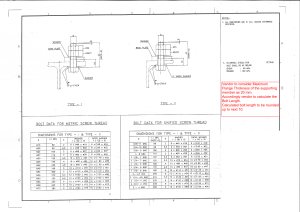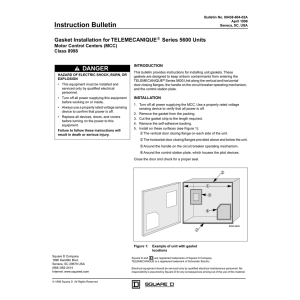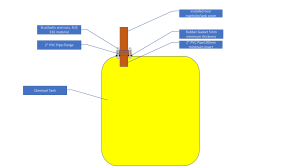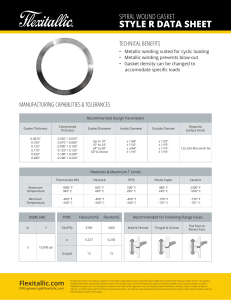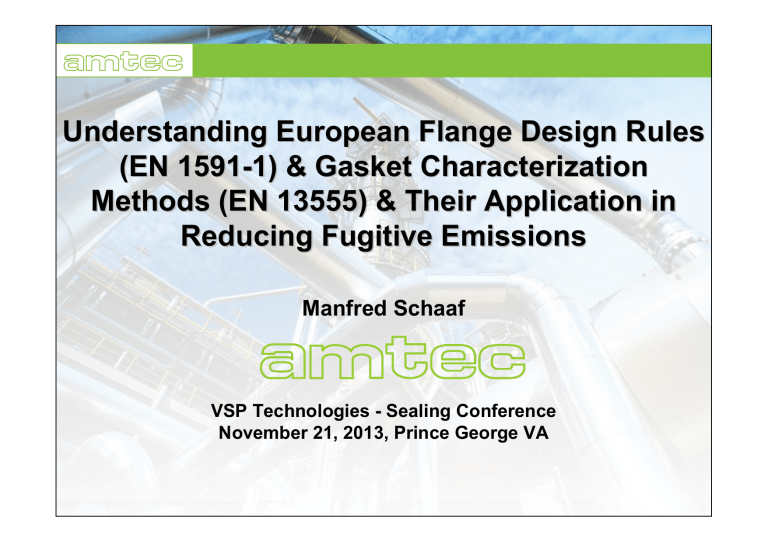
Understanding European Flange Design Rules (EN 1591-1) & Gasket Characterization Methods (EN 13555) & Their Application in Reducing Fugitive Emissions Manfred Schaaf VSP Technologies - Sealing Conference November 21, 2013, Prince George VA registered 2013 Four Tower Bridge 200 Barr Harbor Drive West Conshohocken, PA 19428 USA Tel.: 610-941-2751 Internet: www.amtec-services.com E-Mail: info@amtec-services.com German Parent Company Advanced Measurement Messtechnischer Service GmbH established 1979 Tel. +49 7133 9502-0 Fax: +49 7133 9502-22 E-Mail: info@amtec.de Sealing Technology ■ Testing Laboratory ■ Testing Equipment ■ Measurement Techniques ■ Calculation Programs TEMES Advanced Tools for the Reduction of Fugitive Emissions (service and software, EN & KTA code, FEA) ■ Bolt Mounting Systems (Hydraulic Tensioners, Measurement Tools) ■ Data Bases Designed (Joint Integrity Management) TEMES (tm) TEsting and Mounting Equipment for Sealings Sealing Technology • References TEMESfl.ai1 TEMESstb.freak Klinger Sealing Technology • References Sealing Technology • References Understanding European Flange Design Rules (EN 1591-1) & Gasket Characterization Methods (EN 13555) & Their Application in Reducing Fugitive Emissions Manfred Schaaf VSP Technologies - Sealing Conference November 21, 2013, Prince George VA Motivation Whoever promises you that he can provide ZERO LEAKAGE, don´t trust him, it is a fairy tale! Fire in a Refinery after a Leakage from a BFJ Origin: Origin: Hamburger Morgenpost Leakage from a Tank Wagon Origin: Origin: Feuerwehr Blieskastel Leakage from a Valve Body Seal Origin: Origin: TAS Schwinghammer Leak Detection of Volatile Organic Compounds Origin: Origin: LDAR Envolve Ltd. Content ■ Background Information ■ European Standards ■ Industry Experience ■ Outlook Content ■ Background Information ■ European Standards ■ Industry Experience ■ Outlook EU and National Legislation (General) EU Legislation (Regulations, Directives, etc.) UK D F E I … European Commission/ Parliament/ Council of Ministers EU Member States Directives are transposed into National Legislation EU and National Legislation (Emissions) EU Legislation (Industrial Emission Directive) BREF European Commission/ Parliament/ Council of Ministers Transposition Tools … TA-Luft … (Technical Instruction on Air Quality Control) VDI Guidelines … … … EU Member States Guideline on Reduction of Emissions ■ EU Legislation: Integrated Pollution Prevention and Control (IPPC) Directive 2008/01/EC Industrial Emission Directive (IED) 2010/75/EU ■ German Legislation: Technical Instructions on the Air Quality Contriol - TA-Luft ■ VDI 2440: Approval of gasket materials as high-grade sealing system in a first-time test („TA-Luft approval“) ■ VDI 2200: Additional demands on high-grade sealing systems in respect of the design, the calculation, and the assembly of bolted flanged joints VDI 2290 Emission control – Sealing constants for flange connections 2012-06 VDI 2290 – Guideline on reduction of emissions ■ Basics for design and calculation of flanged joints □ Applicable calculation rules □ Gasket characteristics EN1591-1 EN13555 ■ Explanations on gasket characteristics for the calculation of flange joints □ Testing procedure □ Interpretation of first-time test □ Selection / interpolation of gasket characteristics ■ Assembly of flanged joints EN1591-4 ■ Tightness demands L0.01 (He) No LDAR program required! Content ■ Background Information ■ European Standards ■ Industry Experience ■ Outlook Technical Committee TC 74 “Flanges and their Joints” ■ WG 1 Basic Standards ■ WG 2 Steel Flanges (PN and Class) ■ WG 3 Cast Iron Flanges (PN) ■ WG 4 Copper Alloy Flanges (PN and Class) ■ WG 5 Aluminium Alloy Flanges (PN and Class) ■ WG 8 Gaskets ■ WG 9 Bolting ■ WG 10 Calculation Methods Business Plan of TC 74 … It is recognised that industry must reduce its impact on the environment in order to ensure global development for the future. Part of industrial emissions occur through unanticipated or spurious leaks in process systems, e.g. from leaking valves, pumps or flanges. These "fugitive emissions" have not only an impact on the environment, but cause also a tremendous financial burden on industry, because it represents a huge loss of potentially valuable materials, and cause of plant inefficiency. … Business Plan of TC 74 … It is recognised that industry must reduce its impact on the environment in order to ensure global development for the future. Part of industrial emissions occur through unanticipated or spurious leaks in process systems, e.g. from leaking valves, pumps or flanges. These "fugitive emissions" have not only an impact on the environment, but cause also a tremendous financial burden on industry, because it represents a huge loss of potentially valuable materials, and cause of plant inefficiency. … fugitive emissions cause plant inefficency Business Plan of TC 74 (cont´d) … The European standards for the determination of the gasket characteristics and for the flange calculation enable the determination of the required assembly bolt forces to fulfil a demanded tightness class. This shall give the industry the possibility to reduce fugitive emissions in a pro-active manner instead of implementing control measures to find leaks on site and to minimize the leaks in this reactive way. It is therefore crucial to have testing standards as well as technical delivery conditions for gaskets and gasket materials, also a calculation procedure is required for the stress and tightness analysis. … Business Plan of TC 74 (cont´d) … The European standards for the determination of the gasket characteristics and for the flange calculation enable the determination of the required assembly bolt forces to fulfil a demanded tightness class. This shall give the industry the possibility to reduce fugitive emissions in a pro-active manner instead of implementing control measures to find leaks on site and to minimize the leaks in this reactive way. It is therefore crucial to have testing standards as well as technical delivery conditions for gaskets and gasket materials, also a calculation procedure is required for the stress and tightness analysis. … reduce fugitive emissions in a pro-active manner instead of implementing control measures to find leaks TC 74 – Standards under development ■ prEN 13555 rev Flanges and their joints - Gasket parameters and test procedures relevant to the design rules for gasketed circular flange connections Formal Vote 2013-11 2014-03 ■ prEN 1591-1 rev Flanges and their joints - Design rules for gasketed circular flange connections - Part 1: Calculation 2013-11 ■ prEN 1591-4 rev Flanges and their joints - Part 4: Qualification of personnel competency in the assembly of the bolted connectionsof critical service pressurized systems 2013-12 EN 1591-1 - Status quo EN 1591-1 released as an European Standard in 2001 Amendment A1 of EN 1591-1 released as an European Standard in 2009 New Issue in December 2013 Calculation method for gasketed circular flange connections with gaskets inside the bolt circle and without metal-to-metal contact of the flange faces ■ leak tightness and strength criteria are satisfied ■ behavior of complete flanges-bolts-gasket system is considered EN 1591-1 - Treated parameters ■ strength value of flange and bolt materials ■ gasket characteristics ■ thermal loads ■ medium pressure ■ external axial forces and bending moments ■ nominal bolt load ■ possible scatter due to bolting-up procedure ■ changes in gasket force due to deformation of all components ■ influence of connected shell or pipe EN 1591-1 - Specifics ■ elastic deformation balance ■ flange rotation and effective compressed gasket area ■ iterative determination of the required bolt force in assembly to fulfill tightness demands ■ force balance (interaction between all components) ■ virtual flange resistance of the flanges ■ limit load theory (admissibility of plastic deformation) Gasket characteristics (EN 13555) Mechanical characteristics QSmax(RT) MPa Maximum allowable gasket surface pressure at RT QSmax(T) MPa Maximum allowable gasket surface pressure at T EG MPa Modulus of elasticity eGC mm Creep relaxation of the gasket Tightness characteristics Qmin(L) QSmin(L) MPa Minimum required gasket surface pressure for tightness class L during assembly MPa Minimum required gasket surface pressure for tightness class L in operation (in dependence on the gasket surface pressure QA applied during assembly) Additional parameters µG - Friction factor which is necessary for the treatment of shear forces and torsion moments Testing equipment TEMES Deformation characteristic Compression curve P01-IBC-GR 92x49x1.535 mm Test number: 10-412 300 gasket stress [MPa] 250 200 Collapse of the gasket: QSmax 150 100 50 0 0 0.1 0.2 0.3 0.4 0.5 0.6 compression set [mm] 0.7 0.8 0.9 1 Maximum allowable gasket stress QSmax Loading and unloading cycles Compression curve B01-SWG-GR 68.95x56.22x5.192 mm Versuchsnummer: 10-098 800 700 gasket stress [MPa] 600 500 400 300 200 100 0 0 0.5 1 1.5 compression set [mm] 2 2.5 Creep relaxation characteristic Compression creep curve D01-IBC-FA 91.7x49.05x2.845 mm Versuchsnummer: 10-104 60 PQR QR QA QA creep 50 relaxation gasket stress [MPa] 40 QR loading heating-up 30 dwell time under T unloadung 20 10 eGC 0 0 0.05 0.1 0.15 0.2 compression set [mm] 0.25 0.3 0.35 0.4 Tightness characteristics Leakage curve 1.00E+01 1.00E+00 QSMIN ( L ) QSMIN ( L )i QA QAi QSMIN ( L ) j QSMIN ( L )i Q Aj QAi leak rate [mg/m/s] 1.00E-01 QSMIN(L)j QSMIN(L)i 1.00E-02 QSMIN(L) QAi 1.00E-03 QA QAj 1.00E-04 1.00E-05 0 10 20 30 40 50 60 gasket stress [MPa] 70 80 90 100 CEN/TS 1591-4 - Status quo CEN/TS 1591-4 released as an Technical Specification in 2007 Issue as an European Standard in November 2013 Process for training and compentency assessment of personnel in the assembly of bolted flanged joints fitted to equipment subject to PED ■ design codes increasingly require controlled bolt tightening ■ ensure personnel are competent to assemble and tighten bolted joints for a leak-free status throughout its´ service life ■ training, experience and assessment of knowledge are required to achieve competency CEN/TS 1591-4 - Specifics ■ procedural framework must be included within operator´s quality management system ■ route for achieving comeptency in the skills - classroom training and workshop practice written test period of monitored work site experience assessment by a qualified assessor CEN/TS 1591-4 - General knowledge ■ ■ ■ ■ ■ ■ ■ ■ ■ ■ ■ ■ ■ ■ the principles of bolt elongation (strain), bolt load and stress; importance of applied and residual bolt loads; bolt load loss and the implications; effect of coefficient of friction on bolt load when using torque; bolt tightening methods and their relative accuracies; joint assembly methods and tightening procedures; the requirements to meet a specific class of tightness; flange, bolt and gasket types and their limitations; functionality of gasket and seal; factors affecting the degradation of bolted assemblies, e.g. corrosion; common causes of joint failure and leakage; specific health or safety requirements associated with joint components; maintenance requirements of bolt tightening systems; importance of certification and records. CEN/TS 1591-4 - Specific knowledge ■ ■ ■ ■ ■ ■ ■ ■ ■ ■ ■ ■ ■ ■ ■ ■ ■ ■ ■ general health and safety precautions; procedure for preparing a joint for closure; identification of correct joint components; seal face preparation; gasket handling, preparation and installation; functionality of clamp or engineered joints; importance of alignment and gap uniformity; importance of using the specified lubricant; manual and hydraulic torque joint tightening; joint tightening using hydraulic bolt tensioners; techniques for measuring bolt strain; confirming joint can return to service; identifying defects or faults; variance or irregularity reporting; safe joint disassembly; safety requirements when selecting and operating bolt tightening tooling; calibration of bolt tightening tooling; recording bolted joint activity and maintenance of records. Content ■ Background Information ■ European Standards ■ Industry Experience ■ Outlook First experiences with VDI 2290 Although the VDI 2290 was issued only one year ago, the industry has already experience on the use of this guideline in their plants. ■ Revision of pipe classes ■ Imperative of EN 1591 (tightness based design) ■ Greater significance of assembly ■ Introduction of a quality management circle to assure proper function of BFC´s ■ Reduction of incidients during start-up after turnaround Revision of Pipe Classes XXXXXXXX R d e r i u q e r n o i s i v e .. . Pipe Class Calculation First studies have shown that the new guideline will cause large-scale changes in the sealing technology in industry facilities: ■ Some popular gasket material cannot fulfill the tightness requirements for all operational conditions and/or for all nominal sizes of one pipe class. ■ Also commonly used bolt materials (quality 5.6) must be replaced by bolts of higher quality because higher gasket stresses are required. ■ A positive effect will be the determination of bolt forces, torques or bolt elongations as presetting for the fitters. Significance of Assembly Possible improvements in respect of the assembly of flanged joints : ■ Controlled bolt tightening method (at least torque wrenches / tables with torques) ■ Qualified fitters (individual personnel) ■ Independent check-up of the the assembly quality (basis: risk analysis) ■ Installation of a quality management system in the industry plants (e.g. detailed work instructions) Content ■ Background Information ■ European Standards ■ Industry Experience ■ Outlook Quality Management Circle plant engineer data collection in data base gasket characteristics design - geometry (stiffness) - materials - gasket calculation - bolted flange connection - gasket characteristic - assembly force, tightness proof, stress analysis new calculation according EN 1591-1 data base data base loads - every state of operation review of the data sheet for BFC´s feedback & review - feedback - review assembly - in accordance to the requirements - quality assurance (control) data sheet for BFC Different procedures to reduce emissions PROACTIVE APPROACH REACTIVE APPROACH GASKET TESTING CALCULATION GASKET TESTING CALCULATION ASSEMBLY ASSEMBLY LDAR LDAR Extraordinary Shut-Downs Extraordinary Shut-Downs Different procedures to reduce emissions PROACTIVE APPROACH REACTIVE APPROACH GASKET $TESTING $ CALCULATION GASKET $ TESTING CALCULATION $ ASSEMBLY $ ASSEMBLY $ $ LDAR $ LDAR Extraordinary Shut-Downs $ Extraordinary Shut-Downs $$ Contact Please do not hesitate to contact us, if you have any questions on our products and services: Four Tower Bridge 200 Barr Harbor Drive West Conshohocken, PA 19428 Tel.: 610-941-2751 Internet: www.amtec-services.com E-Mail: info@amtec-services.com
